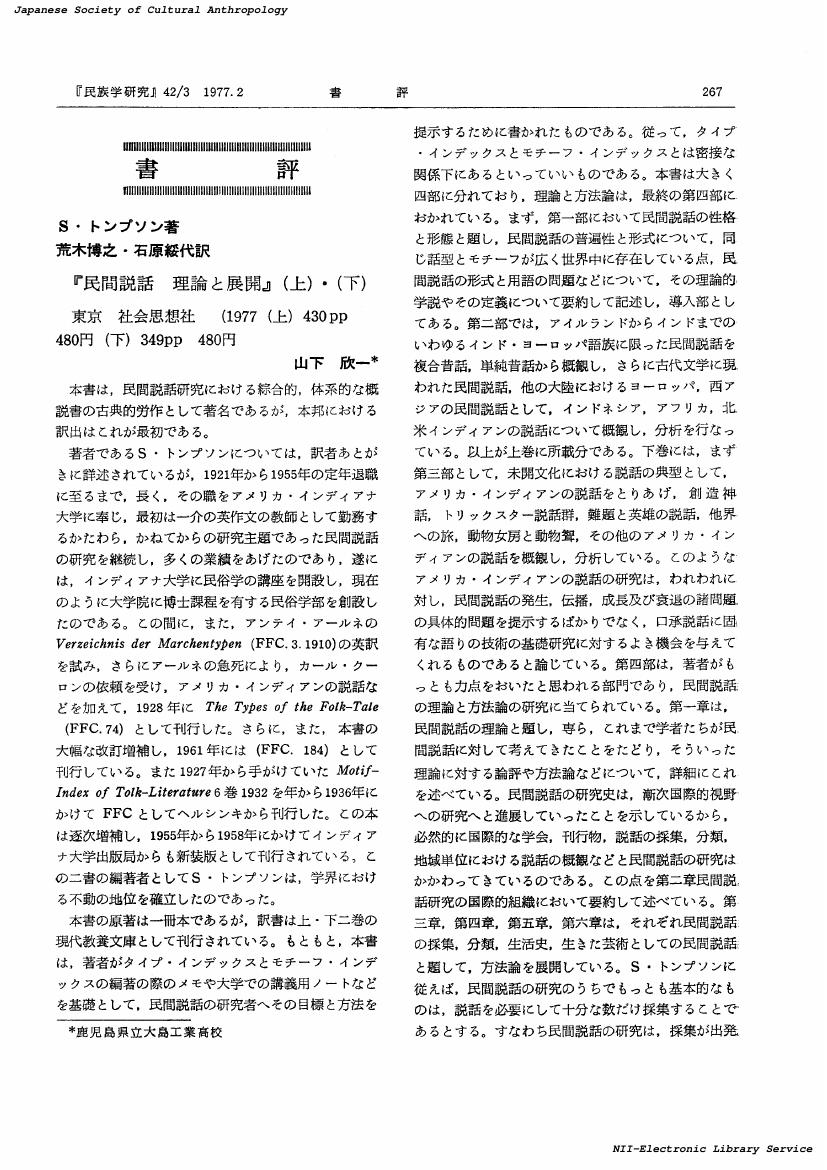1 0 0 0 OA 下野古里村に於ける子供組行事
- 著者
- 高橋 文太郎
- 出版者
- 日本文化人類学会
- 雑誌
- 民族學研究 (ISSN:24240508)
- 巻号頁・発行日
- vol.2, no.3, pp.727-733, 1936-07-10 (Released:2018-03-27)
1 0 0 0 OA 子供組について
- 著者
- 竹内 利美
- 出版者
- 日本文化人類学会
- 雑誌
- 民族學研究 (ISSN:24240508)
- 巻号頁・発行日
- vol.21, no.4, pp.277-283, 1957-12-30 (Released:2018-03-27)
- 著者
- 吉江 貴文
- 出版者
- 日本文化人類学会
- 雑誌
- 民族學研究 (ISSN:24240508)
- 巻号頁・発行日
- vol.68, no.1, pp.23-43, 2003-06-30 (Released:2018-03-22)
本稿は、20世紀前半のボリビアで起こったカシーケ法廷代理人運動を事例として、文書という人工物が先住民社会の在来的土地制度に介入することでどのような波及効果がもたらされるのかを検討し、世界システムの拡張によって生じる中核と周辺の関係を人間と土地と文書の相互作用として捉えなおすものである。近代以降に起こった世界システムの拡張プロセスにおいて、土地にまつわる複数の文書記録が一定の社会内に循環することを制度的に確立させる過程の成立とそれに伴う文書使用の増大・普及は、周辺社会の在来的制度を中核へ接合する媒介として重要な役割を果たしてきた。元来土地所有の正当性を身体的経験に培われた知識や記憶への高い信頼に求めてきたアイマラ系先住民社会も、19世紀末以降に実施された農地改革と近代司法領域への包摂を契機として文書循環のプロセスに巻き込まれていく。それに対し、植民地時代の文書記録に出自を辿るカシーケ法廷代理人運動は、先住民社会の在来的土他制度を基礎付ける規範が、文書使用の増大・普及という支配的潮流に一方向的に飲み込まれることなく、近代司法領域において生き延びる可能性を一貫して模索しつづけた運動であった。本稿では、そうしたカシーケ法廷代理人運動の展開を検討することにより、地域に固有の文脈のなかで文書循環が成立していくプロセスの多様なあり方を明らかにした。
1 0 0 0 OA <37> と <38>? : パプアニューギニア, ファス族の数の数え方について
- 著者
- 栗田 博之
- 出版者
- 日本文化人類学会
- 雑誌
- 民族學研究 (ISSN:24240508)
- 巻号頁・発行日
- vol.49, no.3, pp.252-264, 1984-12-30 (Released:2018-03-27)
1 0 0 0 OA 福岡県八女市近郊農村の変化過程 : 経済構造, 社会組織, 氏神祭祀を中心として
- 著者
- 松永 和人
- 出版者
- 日本文化人類学会
- 雑誌
- 民族學研究 (ISSN:24240508)
- 巻号頁・発行日
- vol.46, no.3, pp.249-274, 1981-12-31 (Released:2018-03-27)
1 0 0 0 OA 済州島の二つの神話の構造分析
- 著者
- 加藤 泰
- 出版者
- 日本文化人類学会
- 雑誌
- 民族學研究 (ISSN:24240508)
- 巻号頁・発行日
- vol.44, no.1, pp.83-90, 1979-06-30 (Released:2018-03-27)
1 0 0 0 OA S・トンプソン著, 荒木博之・石原綏代訳, 『民間説話 理論と展開』(上)・(下), 東京社会思想社, (1977, (上) 430pp, 480円, (下) 349pp, 480円
- 著者
- 山下 欣一
- 出版者
- 日本文化人類学会
- 雑誌
- 民族學研究 (ISSN:24240508)
- 巻号頁・発行日
- vol.42, no.3, pp.267-269, 1977-12-30 (Released:2018-03-27)
1 0 0 0 OA 高山氏の人柱論文について
- 著者
- 大林 太良
- 出版者
- 日本文化人類学会
- 雑誌
- 民族學研究 (ISSN:24240508)
- 巻号頁・発行日
- vol.38, no.1, pp.80-81, 1973-06-30 (Released:2018-03-27)
1 0 0 0 OA インドの「人柱」に関するいくつかの事例 : 高山論文へのコメント
- 著者
- 小西 正捷
- 出版者
- 日本文化人類学会
- 雑誌
- 民族學研究 (ISSN:24240508)
- 巻号頁・発行日
- vol.38, no.1, pp.77-80, 1973-06-30 (Released:2018-03-27)
1 0 0 0 OA 東京アイヌ學會の成立
- 出版者
- 日本文化人類学会
- 雑誌
- 民族學研究 (ISSN:24240508)
- 巻号頁・発行日
- vol.2, no.4, pp.964, 1936-10-10 (Released:2018-03-27)
- 著者
- 山本 真鳥
- 出版者
- 日本文化人類学会
- 雑誌
- 民族學研究 (ISSN:24240508)
- 巻号頁・発行日
- vol.59, no.3, pp.291-296, 1994-12-30 (Released:2018-03-27)
1 0 0 0 OA アスル : エジプト地中海沿岸のベドウィンに見る祖先と自己との関係の表現
- 著者
- 赤堀 雅幸
- 出版者
- 日本文化人類学会
- 雑誌
- 民族學研究 (ISSN:24240508)
- 巻号頁・発行日
- vol.58, no.4, pp.307-333, 1994-03-30 (Released:2018-03-27)
エジプトの西部砂漠地中海沿岸に居住するベドウィンは,祖先との関係が現在生きている人々の関係に反映され,それを整序すると見なす。父と子の間にたどられるアスル(起源)という概念に結集する祖先との関係性は,これまではしばしば「部族」組織と関連づけてとらえられてきた。しかしながら,父系出自集団への帰属は,祖先と自己を結び付ける仕方の一つにすぎず,ベドウィンたちがアスルを社会関係に繁栄する多様な方法の一部としてある。本稿はそうしたアスルの表現の形式を四つに分け,個人の名前への埋め込みと系図化,介在する祖先の網羅と特定の祖先の選出という観点から,たがいを対比して紹介する。それらが全体としてベドウィンの社会的な位置の認識にどのように関わっていくかを論じ,最終的にはベドウィンが自分たちを「ベドウィンである」あるいは「アラブである」と見なす認識も,そうした祖先との関連付けの延長上にあることを指摘する。
1 0 0 0 OA 照葉樹林文化論と縄文文化研究
- 著者
- 渡辺 誠
- 出版者
- 日本文化人類学会
- 雑誌
- 民族學研究 (ISSN:24240508)
- 巻号頁・発行日
- vol.49, no.3, pp.281-283, 1984-12-30 (Released:2018-03-27)
- 著者
- 山本 祐弘
- 出版者
- 日本文化人類学会
- 雑誌
- 民族學研究 (ISSN:24240508)
- 巻号頁・発行日
- vol.14, no.1, pp.36-50, 1949 (Released:2018-03-27)
The author, formerly Director of the Saghalien Museum in Toyohara, after collecting folk-tales among the Saghalien aborigines, comes to the conclusion that the belief in shamanism is the only aspect of their culture which has not been changed by Japanese influence. In the present paper he gives a detailed description of the ceremonies performed by Orokko and Gilyak shamans in January, 1945, in the Otasu reservation near Sisuka, South Saghalien.
- 著者
- 三尾 稔
- 出版者
- 日本文化人類学会
- 雑誌
- 民族學研究 (ISSN:24240508)
- 巻号頁・発行日
- vol.68, no.4, pp.592-595, 2004-03-31 (Released:2018-03-22)
1 0 0 0 OA 人種よさらば, 民族よさらば(いま人種・民族の概念を問う)
- 著者
- 斎藤 成也
- 出版者
- 日本文化人類学会
- 雑誌
- 民族學研究 (ISSN:24240508)
- 巻号頁・発行日
- vol.62, no.1, pp.105-106, 1997-06-30 (Released:2018-03-27)
1 0 0 0 OA 北タイ・クリスチャン・ラフ族における民族関係の経験と自嘲の語り
- 著者
- 西本 陽一
- 出版者
- 日本文化人類学会
- 雑誌
- 民族學研究 (ISSN:24240508)
- 巻号頁・発行日
- vol.64, no.4, pp.425-446, 2000-03-30 (Released:2018-03-27)
語りは語り手の歴史・社会的な背景によって独特のパターンやスタイルをもつ。語り手が自身について語る時, 意識は過去を振り返り, 過去は現在や未来との関連の中で秩序を与えられるため, 語りはつねに語り手の歴史意識に彩られる。一方, 語りは事物ではなく言説であり, 時にはそれが言及する現実からかなりの距離をもった定式化された語りとして繰り返されることもある。以上のような観点から, 本稿では山地少数民族ラフの「自嘲の語り」という独特のスタイルの語りが分析される。少数民族の間にはしばしば自嘲的なスタイルの語りが見られるが, これは彼らが多数民族の支配・圧力の下で暮らしてきた長い歴史の結果であり, 民族間の権力関係が内在化されたものである。現在北タイに暮らす山地民族ラフにおいて, 自嘲の語りはクリスチャン, アニミストの両方に見られるが, 前者においてずっと頻繁に聞かれる。しかしその一見否定的な自己規定の背後にはより肯定的な自己規定が存在し, これらがラフの両義的な民族意識を構成している。キリスト教会による長年にわたる「文明化」政策は, 自嘲の語りをクリスチャン・ラフの支配的言説となし, 人々に「知恵」の欠如こそが民族の今日の苦境の原因だと繰り返す。これに対して, 下層の村人による「舞台裏の」語りは, 間接的に, 含意によってラフ的なるものを評価する。日常の語りという実践行為の場において, 不均衡ながら2つの言説は対抗し, ラフの両義的な民族意識を再生産しているのである。
1 0 0 0 OA カンダーリの治癒過程にみられる自己回復機制について : 宮古シャーマンの事例
- 著者
- 滝口 直子
- 出版者
- 日本文化人類学会
- 雑誌
- 民族學研究 (ISSN:24240508)
- 巻号頁・発行日
- vol.52, no.2, pp.148-158, 1987-09-30 (Released:2018-03-27)
- 著者
- 小池 淳一
- 出版者
- 日本文化人類学会
- 雑誌
- 民族學研究 (ISSN:24240508)
- 巻号頁・発行日
- vol.65, no.4, pp.362-375, 2001-03-31 (Released:2018-03-27)
- 被引用文献数
- 1
本論文は沖縄宮古島の南部諸集落に伝存するソウシ(双紙)を素材にその運用の具体的な様相を記述し、関連する守護神祭祀,暦の製作にも考察を加えながら,その存在と継承とが提起する問題を指摘し,現代日本を対象とする人類学の果たしうる役割について論述したものであるここでは最初にソウシがどのような研究のなかで対象化されてきたかを振り返り,そこから人類学的な問題を抽出する。さらにそれを受けてソウシの利用の様相を筆者自身の調査データと従来の調査記録とに基づいて記述している。ソウシは例外なくマウガンの祭祀に関わり,組み込まれていることからソウシの存在がムトゥの神々と集落の構成員との間に重層複合的な関係が結ばれていることを表現していることが指摘できる。またソウシを暦注書として用いて砂川暦を作成することから近世以降の大雑書と暦との関係がソウシと砂川暦との関係と相似することも看取される。こうしたソウシの運用形態は近世日本の大雑書が南島文化のなかに受容されていった姿を示している。さらにその形成は1714年以前に既に行われており,さらなる考究は南西諸島各地に伝存する多様な暦書の研究によって達成されるであろうことが見通される。そうしてこうした書物,すなわち文字列が内容そのものとは異なった受け止められ方をし,祭祀の再編成に重要な役割を果たしていることから、高度に発展した文字社会においても人類学的なアプローチの方法は独自の位置を占めることができ,さらに歴史学や社会学との協業の一つの可能性を見出すことができるのである。
1 0 0 0 OA 日本語と南島諸語(主としてメラネシア諸語)との語句構成上の異同について
- 著者
- 川本 崇雄
- 出版者
- 日本文化人類学会
- 雑誌
- 民族學研究 (ISSN:24240508)
- 巻号頁・発行日
- vol.39, no.2, pp.113-129, 1974-09-30 (Released:2018-03-27)
We find between Japanese and Austronesian languages the following agreements in morphology: 1. The basic forms of Japanese verbs are the mizenkei (the imperfect form) which ends in -a and the renyokei (the conjunctive form) which ends in -i, and from these forms all the other conjugated forms are supposed to have developed. Many languages in Melanesia and Polynesia have the suffixes -(i)a and -i, the former making intransitive verbs and the latter transitive verbs. Both languages have thus the complementary pair of verbal endings - (i)a and -i. 2. In the Banks' Islands and the New Hebrides as well as in Japan, some nouns have independent and dependent forms, the former being derived from the latter by adding the termination -i. Examples : Japanese te 'hand' <ta-i, fi 'fire' <fo-i ; Mota matai 'eye' <mata-i, ului 'hair' <ulu-i. 3. Adjectival terminations : Japanese -ka, -ki, -ra, -ri, -sa, and -ta ; Melanesian -ga, -gi, -ra, -li, -sa. and -ta ; and verbal terminations : Japanese -si ; -k, -g, -;e, -r, -s, -t ; -f ; -rag, -yag, ; Melanesian -si ; -g, -η, -n, -r, -s, -t ; -v ; -lag, -rag, and -yag. 4. The verbal and adjectival prefixes ma-, ta-, and ka- : Japanese wosa 'interpreter' 〜ma-wos- 'to tell' tur- 'to be followed' 〜ma-tur-(of-) 'to follow saki〜masaki 'happiness' futo 'thick' 〜tafuto 'respectable', awo〜ka-awo 'blue' ; Malay deras 'fast' 〜meuderas 'to hurry', Mota sare 'to tear' 〜masare 'torn', Fiji dola 'to open'〜tadola 'open', voro 'to break'. 〜kavoro 'broken'.













